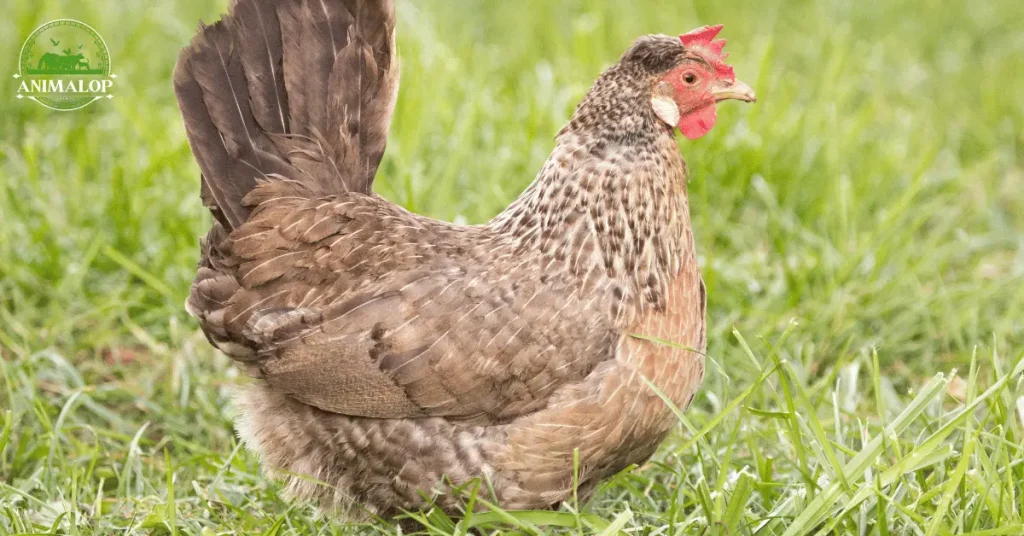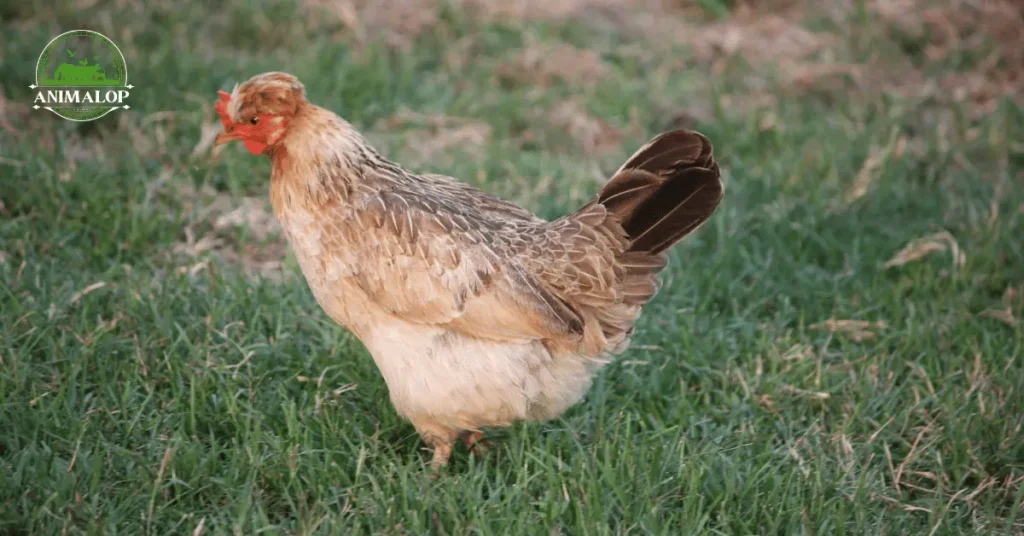Cream Legbar Chicken Breed Profile And Hidden Facts 2024
Have you ever thought if it’s possible to tell a chicken’s gender from the moment it hatches? What if there was a breed that could lay blue eggs and also charm you with its appearance and personality?
The Cream Legbar chicken was created at Cambridge University in Great Britain by scientists who wanted to make a chicken breed that could be easily identified as male or female right after hatching.
What they ended up creating happened more by chance than on purpose. The Cream Legbar is a pretty chicken with nice-looking feathers and a cute crest on its head. It’s also friendly and curious. Plus, it lays a lot of blue eggs.

Cream Legbar Chicken Quick Breed Profile
Get to know about the Sapphire Gem Chicken Breed.
History
The Cream Legbar is a chicken from the UK, along with two other kinds of Legbars in different colors.
It was the second type of chicken made that let people easily tell boys from girls right after they hatch.
The first chicken breed that could do this was called the Cambar. A professor named Reginald Crundall-Punnett created it between 1914 and 1929. He wanted to make a chicken that you could tell its gender right when it was born.
The Cambar came from mixing Barred Rock chickens with Golden Campine chickens. Unfortunately, this breed doesn’t exist anymore, though some have tried to make chickens like it again.
After that, Crundall-Punnett and another scientist, Michael Pease, at Cambridge University’s genetics lab, created the Legbar by crossing Plymouth Rock chickens with Brown Leghorns. They hoped to get chickens that were easy to tell apart as boys or girls right after hatching because of their colors and patterns.
The gold Legbar was officially recognized in the UK in 1945, and the silver Legbar followed in 1951.
The Cream Legbar happened by mistake. It started when Michael Pease was trying to make the gold Legbars better and bred them with white Leghorn chickens. This mix led to chicks with cream colors.
These chickens didn’t have crests and only laid white eggs at first. Then, they were crossed with cream Araucanas, which had a crest, and laid blue eggs. This mix kept the easy-to-tell-apart feature and added the crest and blue egg-laying ability, creating the Cream Legbar.
Cream Legbars were very rare but managed to avoid disappearing completely. They got officially recognized in the UK in 1958, and they’re considered a breed to watch because they’re not very common.
They almost went extinct in the 1970s because people didn’t like blue eggs much then, and these chickens weren’t the best at laying eggs compared to other breeds. A guy named David Applegarth and the Wernless Collection helped save them, and blue eggs became popular in the 1980s.
I couldn’t find any mention of the Cream Legbar or any Legbars on the American Poultry Association’s website or on the Livestock Conservancy Organization’s website.

Eggs
A Cream Legbar chicken can lay about 200 medium to large eggs in a year. That’s about 4 eggs every week when it’s the season for laying eggs. As the chicken gets older, it will lay fewer eggs each year.
The eggs are a really pretty light blue color on the outside, but inside, they look just like any other egg with clear egg white that turns white when you cook it, and a yellow part in the middle.
Most young Cream Legbar chickens, known as pullets, begin to lay eggs around six months old. When they start laying can vary, but it’s common for them to begin in the spring.
Explore the full breed profile of Lavender Orpington Chicken Breed.
Temperament
The Cream Legbar chicken is friendly, always on the lookout, and doesn’t eat much. They’re really good at finding their own food, especially if they can roam around freely.
They’re easy to get along with but can get scared and run away fast if they think there’s danger nearby.
If you want a chicken that can take care of itself, likes to explore, and is nice to have around, this breed could be a great choice.
They’re always searching for something to eat and will look everywhere for something delicious.
The female chickens are great for beginners and kids, but sometimes the male chickens (roosters) can get a bit aggressive because they’re really into protecting their group.
Not all roosters are like this, though; they all have their own ways, and how they act can depend a lot on how they’re raised. If a rooster grows up with other roosters, he might be more likely to start fights.
But if he’s the only rooster and people handle him often, he’s probably going to be more chill and friendly, especially with people he knows.
Even though they’re good at avoiding danger, it’s still important to give them a safe spot to sleep at night away from animals that might want to hurt them.
Cream Legbars usually get along with other chicken breeds without any issues, but since they’re on the smaller side, you’ll want to watch out for bigger chickens that might bully them.
The hens don’t often want to sit on eggs to hatch them, but if they do decide to, they’re good at it.
If you’re hoping to hatch eggs the natural way, you might need to use a hen from another breed that’s more likely to do this, like a Silkie, Orpington, Cochin, or Brahma, or you could use an incubator instead.
Cream Legbar chickens Facts
You can tell if they’re boys or girls right when they hatch, so you always get what you order!
They lay special light blue or light green eggs, which not many other chickens do.
They look super cute with their little feather hats that pop up behind their heads.
Appearance And Characteristics
The Cream Legbar is a type of chicken that’s good at laying eggs. They might look small because their feathers are tight and close to their body, but they’re actually medium-sized. The hens (female chickens) usually weigh about 5.5 pounds, and the roosters (male chickens) are a bit bigger at 7.5 pounds.
These chickens are pretty healthy and can live between 5 to 10 years, depending on how well you take care of them and what you feed them.
When you look at the hens compared to the roosters, the hens have a cream color with gray stripes on their feathers and some salmon-colored spots on their chest and neck. They are darker than the roosters, especially on their back. The roosters are lighter, with a cream-colored back and lighter stripes.
Roosters have bigger red combs and flaps under their beaks (called wattles) than hens, and they usually grow spiky bits (called spurs) on their legs as they get older.
Cream Legbars aren’t too noisy. The hens make soft clucking sounds and sing a little tune when they lay an egg.
Roosters will crow in the morning and keep it up throughout the day. If you only want eggs, you don’t need a rooster since hens can lay eggs without one being there. But without a rooster, the eggs won’t hatch into chicks.
These chickens are tough and can survive both hot and cold weather well. They’re great at finding their own food when they roam around outside.
When you look at them, they’re shaped like a triangle with a long, flat back. The hens have straight tails, and the roosters’ tails stick up at an angle and have long feathers that curve down.
They have a single red comb on top of their heads, red wattles, and their earlobes are white or cream-colored. They also have a yellow beak and legs. One of the cutest features is the crest, a bunch of feathers that stick up behind their comb.
It’s easy to tell the baby chickens apart right after they hatch. The roosters are lighter with a big white spot on the back of their heads, and the hens are darker with stripes. If the hens have a white spot, it’s very small.
Don’t Miss: Welsummer Chicken Breed: Facts, Profile, & History
Health Concerns
Cream Legbars don’t get sick with specific diseases more than other chickens, but you still have to watch out for bugs like lice, mites, and worms. A vet can help you keep them healthy.
These chickens might try to eat anything they find. Make sure there’s nothing dangerous around like Styrofoam, slug pellets, or poison for rats and mice, as these can be deadly.
Baby chicks need special food for chicks, and egg-laying hens need food with lots of protein and calcium.
If you let your chickens roam around outside, they won’t need as much feed from you, but you still need to give them some to make sure they’re getting all the nutrients they need that they might not get just from roaming. In winter, they’ll need extra food to remain healthy and not lose too much weight.
Chickens always need clean, fresh water, no matter the time of year. Make sure their water doesn’t freeze in the cold, so they don’t get thirsty.
If you can’t let your Cream Legbars roam freely, they can live in a chicken coop as long as there’s enough space.
Each chicken needs at least four square feet of space. So, if you have four chickens, you need at least 16 square feet total. They’ll get happier in more space.
Make sure there are enough perches for all your chickens to sleep on comfortably. They each need about 12 inches of space on the perch. They’ll snuggle together for warmth in winter but want more space to spread their wings in summer to stay cool.
You also need nest boxes for the hens to lay their eggs in. You should have one box for every four hens. A box that’s 12 inches all around is a good size for Cream Legbars.

Feed
Once your Cream Legbars are grown up, you should give them food that has 15% to 19% protein in it.
It’s best to let them eat as much as they want, especially if you let them out to roam often.
In the summer, they’ll find a lot of their own food outside and might not eat as much of the food pellets. But, you should still always have food pellets available for them so they get all the nutrients they need. They need to have fresh and clean water.
When it’s cold, make sure their water doesn’t freeze so they can always drink. Staying hydrated is important even when it’s not hot outside.
FAQs
Final Thoughts
These good-looking and curious chickens are great for any backyard.
They’re pretty chill, easy to care for, and love roaming around outside. If you’re dreaming of finding blue eggs in your egg basket, you’ll want these chickens.
They can handle both cold and hot weather, so they’re good for places like Florida, New York, California, or Seattle.
As long as you spend some time with them, Cream Legbars will be friendly and curious when you come around, always ready for a snack.
Even though they’re not super common yet, more and more people are starting to raise them, and they’re definitely a top choice for chicken owners.
